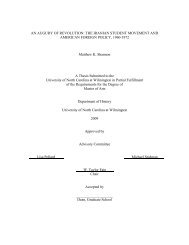HIERARCHAL INDUCTIVE PROCESS MODELING AND ANALYSIS ...
HIERARCHAL INDUCTIVE PROCESS MODELING AND ANALYSIS ...
HIERARCHAL INDUCTIVE PROCESS MODELING AND ANALYSIS ...
Create successful ePaper yourself
Turn your PDF publications into a flip-book with our unique Google optimized e-Paper software.
Thus, an upper bound for Z(t) will be,<br />
lim Z(t) ≤ K = 42.3156486<br />
t→+∞<br />
This is significant, since the Zooplankton concentration will have a maximum of K<br />
and is closer to the type of behavior an ecologist would expect to see in Zooplankton<br />
concentrations. The lower bound of this entity will be zero, since (22) and we know<br />
from biology that Zooplankton concentration cannot be negative. Hence,<br />
∴ 0 ≤ Z(t) ≤ 42.3156486 (23)<br />
However if P (0) ≤ a 16 + a 15 then Z(t) would go to zero as t goes to infinity<br />
because H(t) = 0 hence changing the structure of the equation and driving the<br />
population to extinction.<br />
In order to proceed to the analysis of P(t) we must first find the bounds for M(t).<br />
{<br />
F<br />
M(t) =min<br />
(F + a 5 ) , (1 − e−a 5N ), (e −E P UR (t)<br />
a 2 )(1 − e −E P UR (t)(1+a 3 e(E P UR (t)e1.089−2.12log 10 (a 1 ) ) )<br />
a 1 ))<br />
}<br />
Since M(t) is a minimum function its bounds are,<br />
0 ≤ M(t) ≤ 1. (24)<br />
We now are able to find bounds for P(t),<br />
[ ]<br />
dP [ ]<br />
dt = (1 − E ice (t))a 0 e (0.06933∗E T H 2 O(t))<br />
M(t)P (1 − a 6 )<br />
( )<br />
− (a 9 P ) − H(t)Z − (a 19 P )<br />
49
















